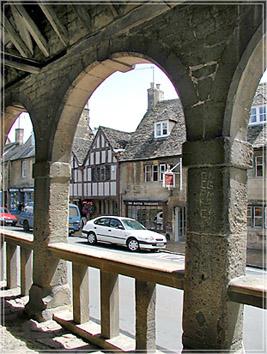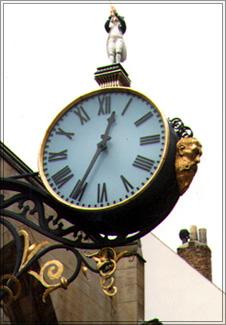AUGUST 2001
| We have just had a lovely
family holiday in the Cotswolds, that part of England so beloved of
tourist boards, calendar makers and jigsaw manufacturers. You know the
picture – golden stone cottages with thatched roofs, roses round the
door, hollyhocks, lavender, honey coloured parish churches, yew and
box and gravestones going back hundreds of years, sunshine and
glorious sunsets. It was all of that. Moreton-in-Marsh, Stow-in-the-Wold,
Chipping Campden, the Slaughters, Northleach, Stanway – these places
really are ravishingly pretty and generally unspoilt though they are
ceasing to be working villages and market towns. But you can’t buck
the market. The same is happening in the Limestone Dales.
We visited Oxford, still and always one of my favourite places. We enjoyed tea at Georgina’s (one of Oxford’s best-kept secrets) in the Covered Market and dinner at the Trout, Godstow, definitely not a secret. As ever, there were peacocks screeching on the roof and fat perch in the river which flowed slowly by as it has done since a nunnery first used the site when England was young. |
Chipping Campden |
Country Life is not a
magazine I usually see but as we were in the Cotswolds it seemed appropriate
to buy a copy. The properties are always an entertainment – a ghastly
‘contemporary’ house (suitable for a footballer or pop star) beside the
Thames in Bray, Berkshire, £2.75 million; a country house with six bedrooms
which we would like as an occasional retreat in Gloucestershire, £900,000; a
well-proportioned house with 100 acres in Windsor Great Park, price so
outrageous they daren’t even print it.
There aren’t many northern references in Country Life so it was good to find an article about ‘the Architect of the North’, John Carr, whose work in the eighteenth century included rich decorative interiors at Heath Hall, Farnley Hall, Aske Hall and other fine Yorkshire houses. But, as the article says, ‘Carr was treated with condescension by 20th century architectural historians, who implied that as he lived in York and seldom worked in the South, he was a provincial – worthy, but a little dull’. ‘Never assume’, says Country Life graciously, ‘that because an architect is provincial he is second rate’. Not an assumption I would ever make.
During the next four weeks there are a few days when both my wife and I are working and the boys, 15 and 13, are, of course, not at school. We were trying to decide whether we could leave them on their own. Now that might sound silly given that when I was their age I used to cycle from Halifax to Grassington and elsewhere in the Dales and my mother never knew what I was doing all day, but the world has changed. Then I read that Harry Hotspur was 12 when he led a successful assault on Berwick-upon-Tweed and at Towton Edward IV was 18 and many of those fighting (and dying) for him much younger. I think we can leave them.
|
|
According to the Wharfedale
and Airedale Observer (where would we be without it?), among items recovered
from Yorkshire motorways this year, as reported by the Highways Agency, are a
washing machine, a gun (and ammunition), a wallet containing £400, a basket
in which were three kittens, a wheelbarrow (in the middle lane), an injured
swan, a surf board, and a tramp (mercifully alive) wrapped in a sheet of
plastic.
Motorway on the Dalesway walk |
| We went to the Treasurer’s
House, a National Trust property in York. This elegant townhouse was
originally the home of the Treasurers of York Minster until the Reformation.
It was restored with idiosyncratic charm by wealthy industrialist Frank Green
between 1897 and 1930 and now has rooms in a variety of styles, a collection
of 17th and 18th century furniture, glass and china, and
a lovely walled garden in the shadow of the Minster. The house is built on the
site of the Roman barracks in York and ghosts of legionaries can be seen
marching through the basement. Well, so they say and I have no reason to doubt
them.
Clock in York |
|
A new car number plate format is being introduced on 1 September. Two letters, followed by two numbers, followed by three letters. Why do I tell you this? It sounds more boring than watching television programmes about DIY, garden ‘improvement’ or how to cook dinner. Well, the point is that as from 1 September the plates of all new cars registered in Yorkshire will begin with the letter Y. Y for Yorkshire. Brilliant. What will they think of next?



